Russia
The Rise of Moscow
The town of Moscow is first mentioned in the historical records in 1147. At first a small trading post, it grew rather quickly due to its strategic location on both east-west and north-south trade routes. After being destroyed by the Tatar invaders in 1238, it was rebuilt and strengthened by Prince Daniel, son of Saint Alexander Nevsky. It grew further under Daniel’s son George, and then under his second son, John Kalita (r. 1328–1341).
For almost 200 more years Moscow was governed by a succession of prudent, shrewd, efficient rulers who were determined to unite the feuding Russian principalities under her authority, with the long-range goal of overthrowing the Tatar yoke. These rulers offered refuge to people fleeing from the Tatar domains to the south, and they learned how to deal skillfully with the Tatar overlords.
With Kievan Rus’ almost entirely devastated by the Tatars, and with the gradual strengthening and expansion of the Muscovite state, it was perhaps inevitable that eventually the Church would move her headquarters from Kiev to Moscow. This happened in 1325 under St Metropolitan Peter (r. 1281–1326), who immediately began construction of the magnificent Cathedral of the Dormition (Uspenski Sobor) in the Kremlin in Moscow. This church remains to this day the main cathedral for the entire Russian Orthodox Church.
Saint Sergius of Radonezh
The great Saint Sergius was born in 1314 in the northern city of Rostov the Great. His godly parents, Kirill and Mary, were of aristocratic background. His father was a confidant of the prince of Rostov, with whom he traveled when the prince negotiated with the Tatar Golden Horde. In 1328, as Prince John Kalita of Moscow began the process of annexing Rostov, Sergius’s family moved much closer to Moscow, to the town of Radonezh.
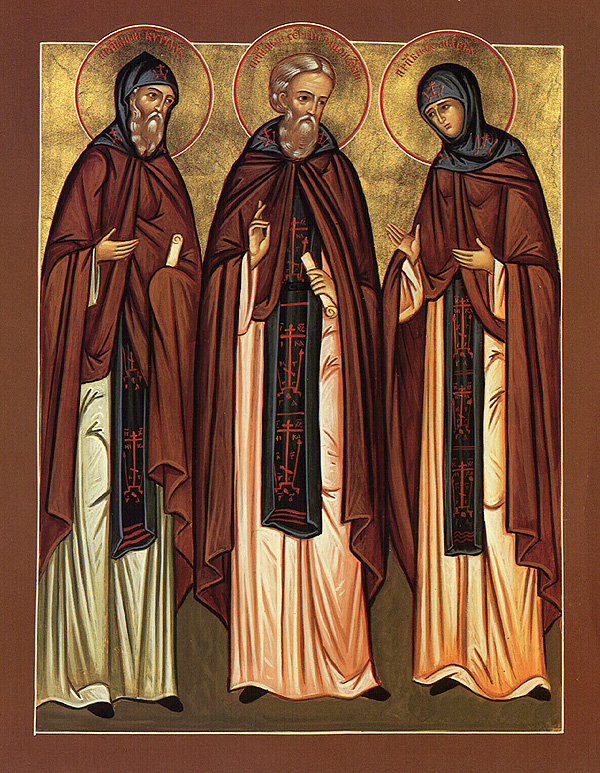
Sergius showed a calling to the ascetic, spiritual life from his earliest days. After his parents entered monasticism later in life and died shortly thereafter—they are venerated as Saints Kirill and Mary in the Russian Church—he and his older brother Stephen selected an isolated spot in the dense forest near Radonezh, where they began a life of seclusion and prayer. After a year or two, Stephen returned to “civilization” due to the rigors of life in the wilderness, while Sergius stayed on alone in his forest paradise.
After a few more years, several others joined Sergius in the little monastic community that he dedicated to the Holy Trinity. The number of monks stayed at around twelve for several more years, until in 1347 a rich and famous abbot from Smolensk named Simon came and asked to be received into the community as a simple monk. His gift of money was used to build a new church.
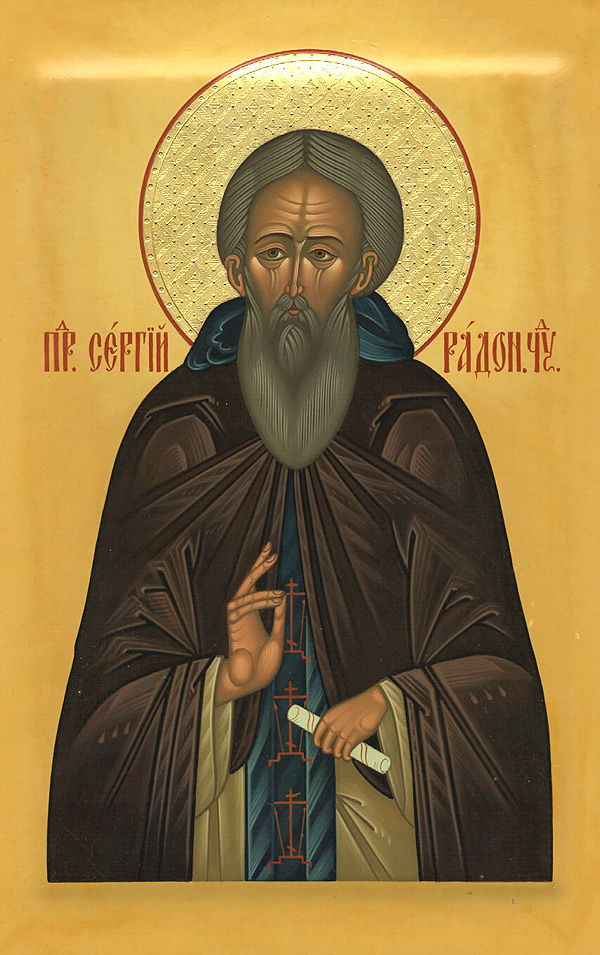
At this point many more came to join the community, and Sergius, very reluctantly, accepted to be officially named the abbot. Yet even after being made abbot, he still continued to serve his monks by chopping wood, drawing water, and making clothes for them, allowing them to copy manuscripts and paint icons. He was a strict ascetic, a practitioner of silent prayer, and a mystic graced with divine visions and living communion with God.
In 1354 word came from the hesychastic Patriarch Philotheos Kokkinos of Constantinople that the community should become organized as a cenobitic (communal) monastery. As the Russian Church was still part of the Patriarchate of Constantinople in the 14th century, Saint Sergius felt obliged to agree to this change, which was also urged upon him by Saint Alexis, Metropolitan of Moscow (r. 1353–1378).
Over the years the monastery continued to grow. Eventually it became recognized as the center of Russian monasticism. And as would happen many times as monastics formed communities further and further into the wilderness to the north and east, settlers came to live around the monastery, and a sizable town developed.
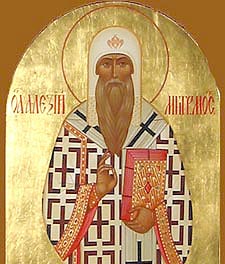
Saint Sergius became so well known as a holy, humble man of God that he was often consulted by Saint Alexis, Metropolitan of Moscow and other prominent leaders of the country. One of these, Saint Dimitri Donskoi, Grand Prince of Moscow (r. 1360–1389), rebuilt the walls of Moscow in defiance of the Tatar overlords. When the Tatars, in response, amassed a huge military force to march towards Moscow, Dimitri rallied nearly all the Russian princes to join him in raising a large number of warriors to defend their lands.
At the moment of final decision, Grand Prince Dimitri consulted Saint Sergius, who advised him to advance towards the Tatars, to meet them in battle across the Don River in the Tatars’ heartland in the open steppes. The forces met at the Battle of Kulikovo Pole, on September 8, 1380. Miraculously, the outnumbered Russian forces prevailed. This victory marked the beginning of the end of the Tatar overlordship, even though the Russians had to continue paying tribute to them until 1480.
The legacy of Saint Sergius to Russia and the Orthodox Church is immeasurable. His direct disciples founded nearly thirty monastic centers in northern Russia around which lands were settled and developed. Between 1400 and 1600, some 250 monasteries were established either through the direct or indirect inspiration of Saint Sergius. The mystical spiritual life of the Russian Church, as well as the interrelation between the Church and the socio-political life of the Russian nation in later times, were rooted in the person and work of the illustrious and exceptionally beloved Saint Sergius of Radonezh.
Saint Stephen of Perm
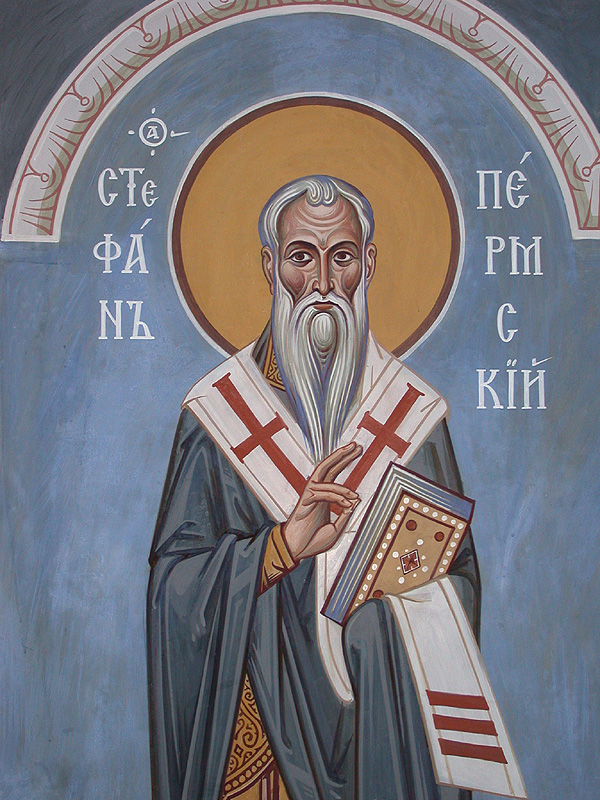
A contemporary and friend of Saint Sergius, Saint Stephen of Perm (1340–1396), was a learned bishop who undertook missionary work among the Zyrian tribes living just west of the Ural Mountains. Saint Stephen created an alphabet for the Zyrian language, and translated numerous Church writings into this language. Thus he continued the Byzantine tradition of fostering Church life in the vernacular in new regions, and he laid the spiritual foundations for the future missionary work of the Russian Church among the Siberian tribes, and later in China, Japan, and Alaska.
Saint Andrei Rublev
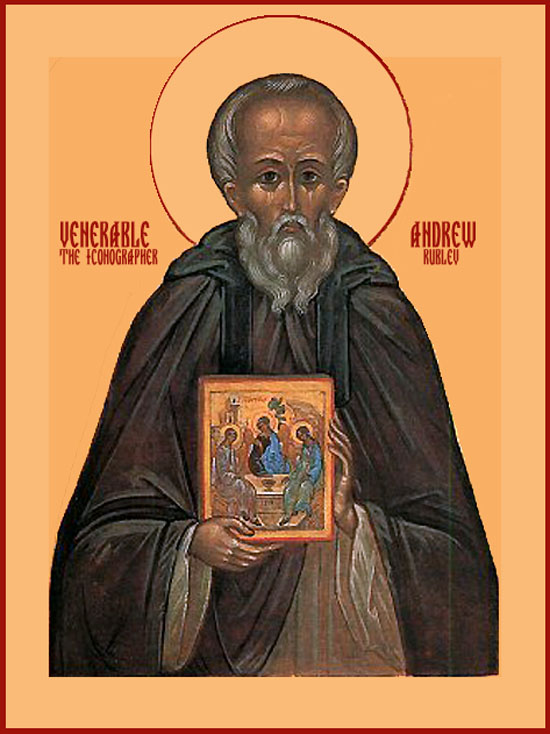
Saint Andrei Rublev (d.c. 1430), the greatest Russian iconographer and perhaps the greatest iconographer in Orthodox history, did his marvelous work at the end of the 14th and the beginning of the 15th centuries. He was a monk of the Holy Trinity Monastery founded by Saint Sergius of Radonezh. Much influenced by the illustrious Byzantine iconographer Theophanes the Greek, Saint Andrei worked together with his friend Daniel the Black.
Rublev’s most famous work is the icon of the Holy Trinity, painted for the iconostasis of the new church built at his monastery. This profoundly moving icon depicts, in a perfect harmony of colors and lines, the Three Angels who visited Abraham and Sarah (Gen 18). During this same period there was a renaissance of Church art in the Byzantine Empire, with many famous frescoes and mosaics coming from this time.
